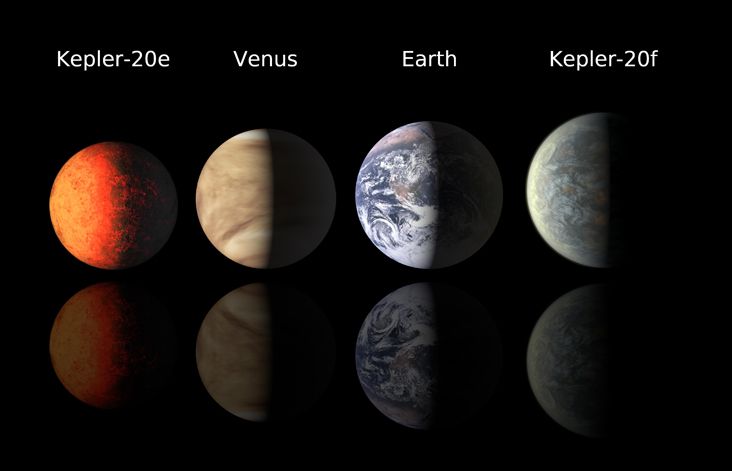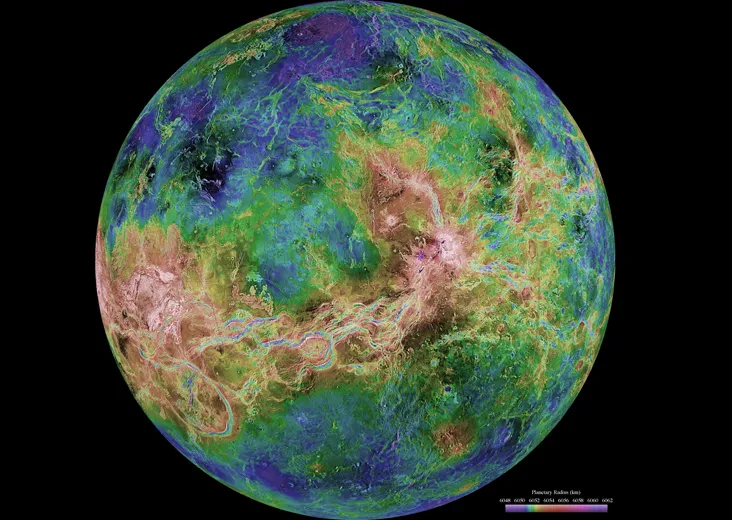The Case for Going to Venus
Sending a probe to Earth’s lifeless twin could help us understand how life rises—and falls—on faraway planets
/https://tf-cmsv2-smithsonianmag-media.s3.amazonaws.com/filer/7e/29/7e29b02b-f0a1-4257-b0b5-8f4a51212d4b/venus_br_2.jpg)
David Grinspoon looked as if someone had died. It was January 2017, and the astrobiologist had just received bad news.
NASA had recently announced the results of its Discovery Program competition, which would decide where the agency would send its next outer space probe. The options: two asteroid missions or two individual Venus orbiters (another option involved an infrared space telescope). Grinspoon had been investigating Venus for most of his 30-year career. But NASA, to his chagrin, had gone with the asteroids.
"People talk about finding Earth 2.0," Grinspoon told me at the American Astronomical Society's winter meeting, frustration evident in his voice. "We have Earth 2.0 sitting right there, and we're ignoring it."
Over the last 65 years, NASA has sent nine orbiters and eight landers or rovers to Mars, triggering a wave of public fascination with the Red Planet. Over the same period, the agency has sent just three orbiters to Venus, the planet whose size and mass are so close to our own that it's often referred to as “Earth's twin.” That's a shame, says Grinspoon, because Venus has the potential to tell us far more about both our own planet and Earth-like worlds around other suns.
Today Venus is a smoldering death trap, with a thick atmosphere that traps heat in an extreme version of Earth's own global warming effect. But it once hosted liquid oceans, and may have been the solar system's first habitable planet. Understanding what made Venus spiral out of control could help scientists understand how more life-friendly planets are able to remain hospitable, as well as provide a hint of what Earth could face should our own atmosphere veer too far off-track.
“It’s incredibly scientifically compelling to understand a planet that’s essentially in the same part of the solar system, the same size as Earth, the same mass of Earth—and yet is so different,” says planetary geologist David Senske, a research scientist at NASA's Jet Propulsion Laboratory in California who has worked with Grinspoon. Senske, too, is already looking toward the next potential Venus mission.
But after the most recent defeat, Grinspoon isn’t so sure. “Eventually, it will happen, but I’m not holding my breath,” he says. “Like Charlie Brown, I’ve run to kick that football many times, and ended up on the ground, looking up at the sky, wondering what happened.”

A Tough Nut to Crack
When it comes to habitable worlds, astronomers tend to focus on what’s known as the Goldilocks zone, or zone of habitability: that narrow band of space in which a planet is neither too hot nor too cold for liquid water to exist on the surface. That’s why exoplanets orbiting their stars at just the right distance—like three of the seven planets in the newly discovered TRAPPIST-1 system—tend to attract a lot of attention. We hope one will end up being the just-right bowl of porridge that can sustain life.
Earth’s conditions, of course, are considered the ideal for harboring life. But if Earth is the ideal, then Venus is a pretty close match. At 7,500 miles in diameter, the Morning Star is only slightly smaller than Earth and a bit less massive. And despite its current dry climate, observations from NASA's Pioneer mission have suggested the planet once held a liquid ocean, and models that Grinspoon worked on suggest that the ocean may have lasted for billions of years, giving life plenty of time to evolve.
At some point, however, the planet’s atmosphere took over. An overabundance of carbon dioxide triggered an extreme global warming effect, which resulted in the destruction of the planet’s most habitable regions. Today, temperatures at the surface reach a scorching 470 degrees Celsius, and the crushing surface pressure is comparable to what you’d find more than half a mile beneath Earth’s oceans. The dense clouds of sulfuric acid only serve to make the planet more intimidating.
That may help explain why NASA has remained hesitant to invest in exploring the planet, preferring to turn its attention toward the less-threatening Mars or other parts of the solar system. When it comes to understanding how the planet became so hellish, “Venus is a tough nut to crack,” Senske says.
According to Jim Green, director of NASA's planetary science division, part of the reason the agency has shied away from Venus in recent years is due to the wealth of potential targets available to explore. “We have such an embarrassment of riches in this solar system,” Green says. Funding, as always, is another issue: “We have so many things that we want to do that we just can’t do it all.”
Yet Green insists that the space agency hasn’t permanently abandoned Earth’s twin. “We’re serious about Venus—we’ve always been serious about Venus,” he says. He points out that NASA took a brief hiatus from Mars as well, before diving in with the latest Curiosity mission and orbiters. Of course, the Red Planet’s break lasted less than a decade—while NASA’s last Venus mission, Magellan, ended in 1994.
Venus may not prove ripe for life today, but it could help scientists figure out what to look for as they probe potentially habitable worlds beyond the solar system. Understanding just how much of the planet’s downward spiral relates to its location and how much relies on other characteristics could help scientists figure out which of the rocky, Earth-sized worlds around other stars might be habitable—and which might end up being another Venus.
“If we want to know how to lose habitability on the inner edge of the habitable zone, there’s no better place to look than Venus,” says Grinspoon.
Exoplanet scientists are only just beginning to learn about the cloudy atmospheres of distant worlds, with a strong focus on the more massive gas giants. Over the last decade, they've turned the Hubble Space Telescope towards exoatmospheres, and NASA's upcoming James Webb Telescope, should help part the clouds even further when it launches in 2018. As our ability to probe exoplanet atmospheres improve, Venus’ clouds could help us decipher other rocky exoplanets.
“It really does come down to the atmospheric characterization of these worlds to know what it’s like. That’s going to be key in the future,” says Hannah Wakeford, an exoplanet scientist at NASA’s Goddard Space Flight Center who investigates the atmospheres of worlds outside the solar system. “Understanding the critical differences between our two planets is really an important thing we should be doing.”

Is Venus Rising?
Although NASA hasn’t sent a mission to Venus in nearly 30 years, the agency has kept a wandering eye on the planet. Galileo and Cassini both flew by on their way to the outer planets, and MESSENGER snuck a peek en route to Mercury.
In fact, the United States may be helping with the next Russian mission to Venus. Later this week, a team of NASA-sponsored scientists will meet with the Russian Academy of Sciences’ Space Research Institute to continue work on the proposed Venera-D mission to Earth’s twin, according to a recent press release. Earlier this year, the nations’ Joint Science Definition Team identified their shared science objectives for the planet, which they outlined in a report released last Friday.
The Russian-led mission, whose full name is Venera-Dolgozhivuschaya (meaning "long-lasting"), plans to drop a lander on the surface while also deploying an orbiter to make its own studies. The mission’s science objectives would focus on key questions about the atmosphere and how it interacts with the surface, according to a January report. Senske, who is co-chair of the team, says the lander would resemble Russian landers of the past, surviving for several hours on the surface—a feat in itself.
“The main question for Venus is about the mechanisms which made it so different from the Earth,” says Russian team member and planetary scientist Mikhail Gerasimov by email. “There is a global practical interest about the evolution trend of the Earth.” In other words, studying Venus could help scientists identify if Earth too could one day end up on the climate road to no return.
That global worry is what has drawn Russia and the U.S. together over a proposed Venus mission, despite the changing political climate over the past few years. While the mission isn't confirmed and wouldn’t launch until after 2025, Green seemed unperturbed about the concern that American politics might impact its viability. “In a way, science is that one gratifying thing that continues on no matter what the politics are,” he says, pointing to how scientists from both countries continued to work together through the Cold War. He also highlighted NASA’s “wonderful relationship” with its Russian counterpart when it comes to the International Space Station.
“What our space nations have done, cooperating and working together, really deserves a Nobel Peace Prize,” he says.
If it does move forward, Venera-D could help pull Venus back to the forefront of planetary science as the mission seeks to answer questions about the evolution of Earth and other habitable planets in the universe. As Grinspoon points out, “there is a difference between Earth-sized and Earth-like." Pinpointing what that difference is could help us figure out which of the worlds orbiting nearby stars are truly habitable.
After being part of half a dozen failed Venus mission proposals over his career, Grinspoon is still cautious that the current mission proposal will bear fruit. But others remain hopeful. “Venus’ time is coming,” Senske says. “Stay tuned. I think Venus is rising here.”
/https://tf-cmsv2-smithsonianmag-media.s3.amazonaws.com/accounts/headshot/NTR_headshot.jpg)
/https://tf-cmsv2-smithsonianmag-media.s3.amazonaws.com/accounts/headshot/NTR_headshot.jpg)